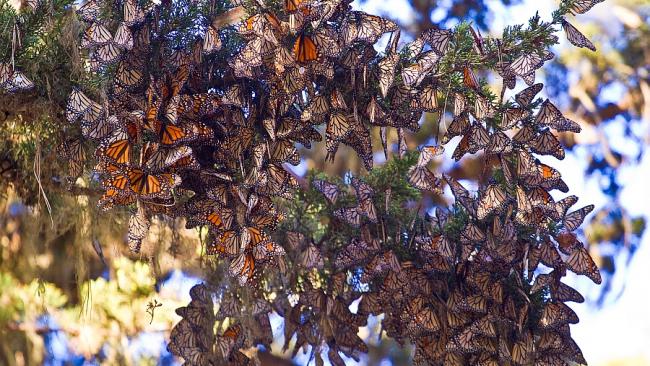
But these days, fewer souls seem to be making the journey.
In recent years, scientists have noticed a disturbing drop in the number of monarchs wintering in Mexico, a trend that could mean that monarchs' remarkable trek may be coming to an end.
Historically, the striking orange butterflies, which are native to the U.S. and Canada, embark on an amazing and somewhat mysterious migration, flying up to 2,800 miles to the forests of central Mexico to hibernate in a 30-by-60 square-foot area that they have never been to before, according to the Washington Post. In the Oyamel fir forests, millions of the stunning butterflies cover the trees in colonies that once spanned nearly 52 acres.
Lincoln Brower, a professor of biology at Sweet Briar College, told the Washington Post that last year, the monarch colonies spanned less than 3 acres, a record low.
This year, that number is expected to be even lower, along with the overall number of butterflies reaching Mexico. Unfortunately, the decline of monarchs in Mexico is part of a 20-year trend that seems to be getting more pronounced. And though it isn't clear that the species itself is in danger, scientists aren't sure what will happen to the monarchs if their pattern of migration were to end.
So what's to blame for the monarchs decline?
Despite efforts by the Mexican government, Brower says that illegal logging has slimmed the butterflies' forest habitat, which makes them less resistant to cold weather. Severe weather has also been a factor: In 2011, a massive drought in Texas killed many of the plants that monarchs feed on and this spring, a cold front held up their migration north. Further compounding the problem is the widespread use of herbicides in the Midwest that kill milkweed, a staple of the monarchs' diet.
On both sides of the border, there are ongoing efforts to protect monarchs. Because of their association with the souls of the dead, some Mexicans have become attached to the butterflies and have formed groups to protect them. PBS reports that the World Wildlife Fund has supported their efforts by establishing reserves, planting trees and monitoring populations.
In the U.S., groups like Monarch Watch and Pollinator Project encourage people to plant milkweed along highways and has enlisted volunteers to create 'backyard waystations' for monarchs at home, reports Gizmodo. Citizen scientist groups like the Monarch Larva Monitoring Project are also collecting data to monitor monarch populations and the New York Times reports that at the University of Minnesota, a coalition of nonprofits and government agencies called Monarch Joint Venture has funded research on conservation efforts.
Luckily, monarchs are a relatively resilient species who have managed to survive for centuries, so Brower hopes that if the weather improves, the monarch population could recover pretty quickly. But if their migration pattern were to completely collapse, monarchs may not be able to bounce back.
For Mexicans who have forged a bond with the stunning butterfly, that would also mean that in the future, they may no longer be able to welcome back the souls of the dead.



Reader Comments